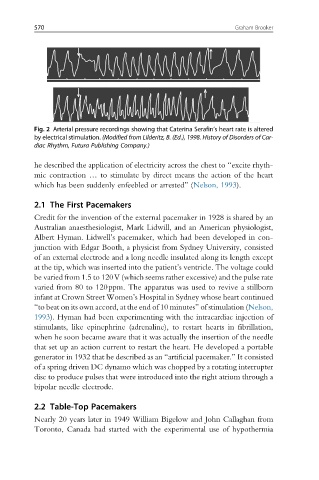Page 577 - Handbook of Biomechatronics
P. 577
570 Graham Brooker
Fig. 2 Arterial pressure recordings showing that Caterina Serafin’s heart rate is altered
by electrical stimulation. (Modified from Lilderitz, B. (Ed.), 1998. History of Disorders of Car-
diac Rhythm, Futura Publishing Company.)
he described the application of electricity across the chest to “excite rhyth-
mic contraction … to stimulate by direct means the action of the heart
which has been suddenly enfeebled or arrested” (Nelson, 1993).
2.1 The First Pacemakers
Credit for the invention of the external pacemaker in 1928 is shared by an
Australian anaesthesiologist, Mark Lidwill, and an American physiologist,
Albert Hyman. Lidwell’s pacemaker, which had been developed in con-
junction with Edgar Booth, a physicist from Sydney University, consisted
of an external electrode and a long needle insulated along its length except
at the tip, which was inserted into the patient’s ventricle. The voltage could
be varied from 1.5 to 120V (which seems rather excessive) and the pulse rate
varied from 80 to 120ppm. The apparatus was used to revive a stillborn
infant at Crown Street Women’s Hospital in Sydney whose heart continued
“to beat on its own accord, at the end of 10 minutes” of stimulation (Nelson,
1993). Hyman had been experimenting with the intracardiac injection of
stimulants, like epinephrine (adrenaline), to restart hearts in fibrillation,
when he soon became aware that it was actually the insertion of the needle
that set up an action current to restart the heart. He developed a portable
generator in 1932 that he described as an “artificial pacemaker.” It consisted
of a spring driven DC dynamo which was chopped by a rotating interrupter
disc to produce pulses that were introduced into the right atrium through a
bipolar needle electrode.
2.2 Table-Top Pacemakers
Nearly 20 years later in 1949 William Bigelow and John Callaghan from
Toronto, Canada had started with the experimental use of hypothermia

